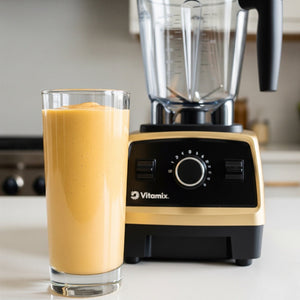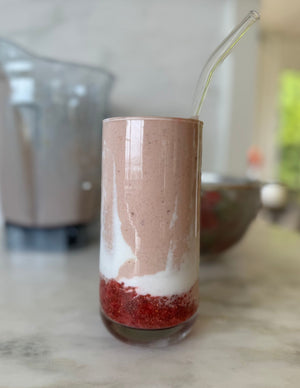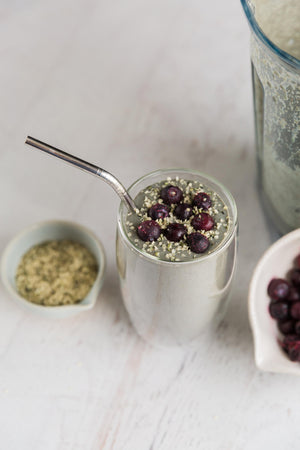If you’ve been scrolling wellness feeds lately, you’ve probably noticed peptides, such as GLP-1, surfacing often. From celebrity transformations to biohacking forums, peptides are being used for everything from weight loss and antiaging to joint support and tissue repair.
Peptides are trending. And for good reason! But is there more to the story? It’s important to be informed on dosing, application, and risk versus reward before moving forward with any peptide treatment, including those for weight loss.
In this article, we’re going to take a high-level look at peptides in general, and then we’ll zero in on some of the more common peptides (yes, including GLP-1) and their usage. Here’s what to expect:
-
What are peptides
-
Different types of peptides
-
Delivery methods
-
Dosing strategies
-
Popular peptide roundup, including GLP-1, BPC-157, CJC-1295, and more
-
GLP-1 deep dive
-
Weight loss myths
-
Supporting GLP-1 naturally
What Are Peptides: Peptide 101
What exactly is a peptide? Peptides are short chains of amino acids that act as chemical messengers in the body. Amino acids are the building blocks of proteins, and whereas proteins are full-length chains of amino acids, peptides are shorter chains.
Unlike full-length proteins, which primarily build and repair tissues like muscles, skin, and organs, peptides can target specific functions such as metabolism, appetite regulation, joint repair, immune support, or skin regeneration. This precision makes them a favorite tool for people looking to optimize health at a cellular level.
Over the past 6-8 years, peptides have transitioned from a niche clinical tool to a mainstream biohacking and wellness strategy. Initially used in medical settings for hormone therapy, metabolic disorders, and injury recovery, peptides are now more widely popular for anti-aging, metabolic optimization, and performance enhancement.
Celebrities, athletes, and wellness influencers helped bring peptides into the spotlight, sharing stories of improved energy, recovery, and body composition. Today, peptides are used in clinical applications and for personalized wellness routines, often in microdoses for long-term health optimization.
This evolution reflects a broader trend in health: leveraging science-backed molecules to support longevity, energy, and vitality.
Different Types of Peptides
Peptides come in a variety of forms depending on their function, delivery method, and target area. Understanding the different types can help you identify which peptides align with your personal health goals.
Functional Categories
Metabolic Peptides: These peptides support weight management, appetite regulation, and energy balance. GLP-1 is a prime example, helping regulate blood sugar, reduce cravings, and improve satiety. Other metabolic peptides can support fat loss, insulin sensitivity, and cardiovascular health.
Anti-Aging Peptides: These peptides focus on skin health, tissue repair, and longevity. They stimulate collagen production, improve skin elasticity, and may reduce the appearance of wrinkles. Examples include GHK-Cu, often used in skincare formulations, and thymosin beta-4, which supports cellular repair.
Joint and Muscle Peptides: These peptides support recovery, muscle growth, and joint health. Athletes and biohackers often use them to recover faster, maintain mobility, and optimize musculoskeletal function. Common examples include BPC-157 for tissue repair and CJC-1295 for muscle recovery and growth hormone support.
Cognitive and Neuropeptides: Some peptides target brain function, cognition, and mood, influencing neurotransmitter activity, neuroprotection, and mental clarity. Popular neuropeptides in biohacking circles include Semax and Selank, often used for focus, memory, and stress modulation.
Delivery Methods
Injectable Peptides: Direct delivery allows peptides to bypass digestion, making them highly bioavailable and often more potent. This method is commonly used in clinical settings.
Oral Peptides: These are convenient and easier to integrate into daily routines, though absorption can vary depending on peptide structure and formulation. Newer oral formulations are showing promising bioavailability for certain peptides.
Topical Peptides: Applied to the skin to support collagen production, firmness, and repair. Often used in skincare to target signs of aging, improve elasticity, and enhance barrier function.
Dosing Strategies
Pharmaceutical Doses: High-dose peptides are prescribed in medical contexts for conditions like metabolic disorders, hormone therapy, or injury recovery. These require careful medical supervision.
Microdosing: Lower, controlled doses are often sufficient to see benefits without overstimulating the system. Microdosing is popular in wellness and longevity circles, supporting long-term optimization while minimizing potential side effects.
To hear more on the microdosing of GLP-1 peptides, listen to my interview with Dr. Tyna Moore on the Be Well Podcast, Episode 306: The Truth About GLP1 Peptides: Benefits, Myths & Misconceptions.
At the end of the day, the most effective peptide strategies for dosing are individualized. Goals vary. Some may prioritize fat loss, others anti-aging, joint support, or cognitive enhancement. Working with a qualified practitioner ensures the right peptide, dose, and timing for your unique needs, making your peptide regimen both safe and effective.
Peptide Round-Up: Popular Peptides and Their Benefits
While there are a wide variety of peptides available, each targeting specific areas of health, some have dominated media space on the market. Here’s a practical overview of some of the most popular peptides in wellness and biohacking circles, and what they can do for you:
1. GLP-1
-
Primary Use: Appetite regulation, blood sugar management, weight support
-
Benefits: Reduces cravings, improves satiety, stabilizes energy, supports long-term metabolic health
-
Notes: Naturally produced in the gut; can be supported through diet, lifestyle, and, under guidance, supplementation
-
Common Pharmaceuticals Containing GLP-1 Peptide: Ozempic, Wegovy, Rybelsus, Mounjaro, Zepbound, Trulicity
As a nutritionist working with clients who care not just about looking good today, but feeling incredible for decades, I’m always curious about how science-backed tools like GLP-1 can support long-term health.
People often ask me about GLP-1 supplements, particularly for weight management, all the time. And while they can be effective, understanding how GLP-1 works in your body is key to making it work for you.
2. BPC-157
-
Primary Use: Joint, tendon, and tissue repair
-
Benefits: Supports healing from injuries, reduces inflammation, promotes musculoskeletal health
-
Notes: Popular among athletes and those recovering from injuries
Known as the “body protection compound,” BPC-157 is a peptide naturally derived from stomach acid. It’s best known for tissue repair, gut healing, and reducing inflammation. Research suggests it can speed recovery from injuries, protect the gut lining (especially from stress or NSAID use), and even support joint and tendon health (PubMed, Science Direct).
3. CJC-1295
-
Primary Use: Muscle recovery and growth hormone support
-
Benefits: Enhances lean muscle mass, improves recovery, supports metabolism
-
Notes: Often paired with other peptides like Ipamorelin for synergistic effects
CJC-1295 is a growth hormone-releasing hormone (GHRH) analog. It helps your body naturally increase its own growth hormone production. This can support muscle preservation, fat metabolism, better sleep, and recovery. It’s often used in longevity and performance circles as a gentler way to enhance growth hormone without direct HRT.
4. GHK-Cu
-
Primary Use: Anti-aging and skin repair
-
Benefits: Stimulates collagen production, improves skin elasticity, supports wound healing
-
Notes: Often used topically or in low-dose formulations for skin rejuvenation
This is a copper-binding peptide that plays a big role in skin rejuvenation, collagen synthesis, and wound healing. You’ll find GHK-Cu in topical formulas because it can reduce fine lines, improve elasticity, and speed skin repair.
5. Thymosin Beta-4
-
Primary Use: Cellular repair and recovery
-
Benefits: Promotes tissue repair, supports immune health, aids in recovery from physical stress
-
Notes: Used in both wellness and clinical settings
Thymosin Beta-4 is a naturally occurring peptide involved in tissue regeneration and immune modulation. It helps increase cell migration (which supports healing) and has shown promise for muscle recovery, injury repair, and even heart and brain tissue regeneration.
6. Neuropeptides (Semax, Selank)
-
Primary Use: Cognitive support, focus, and mood regulation
-
Benefits: Enhances mental clarity, reduces stress, supports memory
-
Notes: Popular among biohackers for productivity and stress management
These are brain-supporting peptides designed to enhance focus, mood, memory, and stress resilience:
-
Semax: Known for boosting cognitive performance and neuroprotection, often used to enhance learning or mental clarity.
-
Selank: Offers a calming, anxiolytic effect, helping to reduce stress and support emotional balance. Think of it as a natural nootropic for mood.
Now that we’ve covered the different types of peptides and how they can support metabolism, recovery, anti-aging, and cognitive health, let’s take a closer look at GLP-1, the peptide that’s currently making headlines in wellness and biohacking circles.
What is GLP-1?
GLP-1, or glucagon-like peptide-1, is a hormone your body produces naturally in the gut. Its job is to help you feel full, regulate blood sugar, and support digestion. Essentially, it’s one of your body’s built-in tools for metabolic balance.
When I work with clients like celebrities, executives, or everyday people, the first step is always optimizing what your body already has. GLP-1 supplements can enhance this system, but the real magic comes from understanding how your body produces and responds to GLP-1.
How GLP-1 Naturally Works in the Body
Understanding how GLP-1 works (and how to support it naturally!) can help you harness its benefits for sustainable weight management and long-term metabolic health.
GLP-1 works by signaling your pancreas to release insulin after a meal, helping your body manage glucose efficiently. At the same time, it slows down digestion, keeping you fuller longer. This makes it a hot topic in weight management research, because a hormone that naturally reduces cravings and helps regulate energy balance can be a powerful ally.
In my practice, I think of GLP-1 as a tool, not a shortcut. Whether through lifestyle strategies or thoughtful supplementation, the goal is to enhance your body’s natural processes while building habits that last.
GLP-1 for Weight Loss
One of the reasons GLP-1 supplementation has become so popular is its role in weight management. It has been shown to help regulate appetite, control portion sizes, and improve blood sugar stability, all of which are essential for sustainable fat loss.
But here’s the thing I always tell my clients: supplements alone won’t make you fit, energized, or youthful. They can be used as a tool to give you a jumpstart, but lifestyle change (not GLP-1 pharmaceuticals) is where weight loss meets sustainability.
So, let’s first talk about what we can do to encourage our body’s inherent release of GLP-1:
-
Eat high-fiber, whole foods
-
Hit your daily protein goals with high-quality, clean protein
-
Ensure the Fab Four at every meal
-
Move your body consistently
-
Prioritize sleep and stress management
GLP-1 supplements can be an option, especially for those who need extra support, but they are most effective in the short and long-term when combined with a well-rounded, nutrient-rich lifestyle that encourages the natural release of GLP-1.
Essentially, nailing a short list of foundational, healthy lifestyle habits is what will help you nail your health and body composition goals for the long haul
Benefits Beyond GLP-1 for Weight Loss
GLP-1 isn’t just about the number on the scale. Naturally supporting the body’s release of this hormone can:
-
Improve blood sugar regulation
-
Enhance energy and metabolism
-
Support long-term metabolic and cardiovascular health
For my clients, especially those in the public eye, these benefits go beyond aesthetics. We’re focused on longevity, energy, and feeling good in our bodies for years, not just months.
Common Weight Loss Myths About GLP-1
Myth 1: GLP-1 guarantees rapid weight loss.
Truth: It supports appetite and blood sugar regulation, but lifestyle choices are still critical.
Myth 2: Supplements replace healthy eating and exercise.
Truth: Think of GLP-1 as a partner to your habits, not a substitute.
Myth 3: Everyone responds the same way.
Truth: Individual responses vary. Genetics, diet, activity level, and stress all play a role.
How to Support GLP-1 Naturally
As mentioned earlier, peptide supplementation with GLP-1 can be a powerful tool, but it is not a replacement for a balanced lifestyle. Think of it as an add-on to your routine, enhancing the benefits of healthy habits rather than doing the work alone.
The foundation always comes first: food, sleep, movement, and stress management.
One of my favorite frameworks for supporting GLP-1 and stabilizing blood sugar is the Fab Four, which I teach to all my clients, from busy executives to A-list celebrities who are focused on long-term health. The Fab Four includes:
-
Protein: Eggs, fish, and high-quality animal proteins help regulate appetite and stimulate GLP-1 release.
-
Healthy Fats: Avocados, olive oil, nuts, and seeds slow digestion and keep you feeling full longer.
-
Fiber-Rich Foods: Dark leafy greens, psyllium, acacia, chia, flax, and low glycemic fruits feed your gut microbiome, which is critical for natural GLP-1 production.
-
Greens: Brussels sprouts, broccoli, cauliflower, cabbage, and leafy greens provide nutrients without causing blood sugar spikes.
Want to master the Fab Four? I make it easy in this guide.
Fermented foods can also enhance gut health, which plays a role in hormone signaling. And in addition to balanced meals, regular movement, quality sleep, and stress reduction are essential for supporting GLP-1 naturally.
Supplements can be layered on top if you and a provider determine it is necessary, but the most effective strategy is always optimizing your body’s natural production first. Working with a healthcare professional ensures any supplementation is safe, evidence-based, and tailored to your goals.
Hesitations and Potential Risks of Peptide Usage
Regulatory Gray Area: Most peptides (like BPC-157, CJC-1295, or Thymosin Beta-4) are not FDA-approved for general use. Some are approved for specific medical conditions or research purposes, but many available online fall under “research chemicals” which means there is no regulation, no quality control, and no guarantee of purity or dose accuracy.
Limited Long-Term Research: Even though peptides mimic natural signaling molecules in the body, long-term human data is lacking for many of the trendy peptides.
Hormonal + Immune System Interactions: Some peptides act on growth hormone or immune pathways, which means they have potential to shift delicate hormonal or immune balances. This could potentially increase risk for cell proliferation or tumor growth in predisposed individuals.
Contraindications and Cautions: People that should proceed with caution or avoid them entirely: those who are pregnant and/or breastfeeding, those with active cancer or cancer history, those with autoimmunity or inflammatory diseases, children and teens.
It’s also important to note that because peptides can deliver rapid results, there’s a temptation to “stack” multiple at once, which can overload pathways, stress the liver/kidneys, or blunt your body’s natural feedback loops.
Bottom line is that while peptides hold incredible potential, they’re not one-size-fits-all. And it’s best to work with a licensed medical provider who can source pure, personalized peptides while monitoring your labs.
I will always suggest focusing first on foundational health: sleep, nutrition, blood sugar balance, movement, and stress regulation. These pillars naturally support many of the same pathways peptides target, and in a much less risky and much more sustainable fashion.
More Resources to Support Natural Peptide Production, Including GLP-1:








